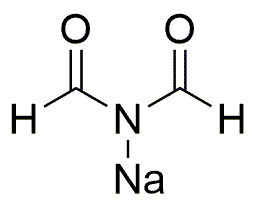Sodium diformylamide is widely utilized in research focused on:
- Organic Synthesis: This compound serves as a versatile reagent in the synthesis of various organic molecules, particularly in the preparation of amides and other nitrogen-containing compounds, which are essential in pharmaceuticals and agrochemicals.
- Catalysis: It acts as a catalyst in various chemical reactions, enhancing reaction rates and yields. This is particularly beneficial in industrial processes where efficiency and cost-effectiveness are crucial.
- Polymer Chemistry: Sodium diformylamide is used in the production of specialty polymers, contributing to materials with improved properties such as flexibility and thermal stability, which are important in automotive and aerospace applications.
- Analytical Chemistry: It is employed in analytical methods for detecting and quantifying certain compounds, aiding researchers in quality control and environmental monitoring.
- Biochemical Applications: The compound is also explored for its potential in biochemical applications, including drug development and enzyme catalysis, providing innovative solutions in the medical field.
General Information
Properties
Safety and Regulations
Applications
Sodium diformylamide is widely utilized in research focused on:
- Organic Synthesis: This compound serves as a versatile reagent in the synthesis of various organic molecules, particularly in the preparation of amides and other nitrogen-containing compounds, which are essential in pharmaceuticals and agrochemicals.
- Catalysis: It acts as a catalyst in various chemical reactions, enhancing reaction rates and yields. This is particularly beneficial in industrial processes where efficiency and cost-effectiveness are crucial.
- Polymer Chemistry: Sodium diformylamide is used in the production of specialty polymers, contributing to materials with improved properties such as flexibility and thermal stability, which are important in automotive and aerospace applications.
- Analytical Chemistry: It is employed in analytical methods for detecting and quantifying certain compounds, aiding researchers in quality control and environmental monitoring.
- Biochemical Applications: The compound is also explored for its potential in biochemical applications, including drug development and enzyme catalysis, providing innovative solutions in the medical field.
Documents
Safety Data Sheets (SDS)
The SDS provides comprehensive safety information on handling, storage, and disposal of the product.
Product Specification (PS)
The PS provides a comprehensive breakdown of the product’s properties, including chemical composition, physical state, purity, and storage requirements. It also details acceptable quality ranges and the product's intended applications.
Certificates of Analysis (COA)
Search for Certificates of Analysis (COA) by entering the products Lot Number. Lot and Batch Numbers can be found on a product’s label following the words ‘Lot’ or ‘Batch’.
Numéro de catalogue
Numéro de lot/série
Certificates Of Origin (COO)
This COO confirms the country where the product was manufactured, and also details the materials and components used in it and whether it is derived from natural, synthetic, or other specific sources. This certificate may be required for customs, trade, and regulatory compliance.
Numéro de catalogue
Numéro de lot/série
Safety Data Sheets (SDS)
The SDS provides comprehensive safety information on handling, storage, and disposal of the product.
DownloadProduct Specification (PS)
The PS provides a comprehensive breakdown of the product’s properties, including chemical composition, physical state, purity, and storage requirements. It also details acceptable quality ranges and the product's intended applications.
DownloadCertificates of Analysis (COA)
Search for Certificates of Analysis (COA) by entering the products Lot Number. Lot and Batch Numbers can be found on a product’s label following the words ‘Lot’ or ‘Batch’.
Numéro de catalogue
Numéro de lot/série
Certificates Of Origin (COO)
This COO confirms the country where the product was manufactured, and also details the materials and components used in it and whether it is derived from natural, synthetic, or other specific sources. This certificate may be required for customs, trade, and regulatory compliance.


